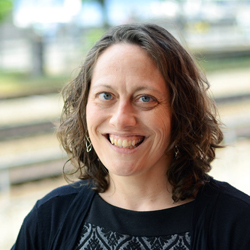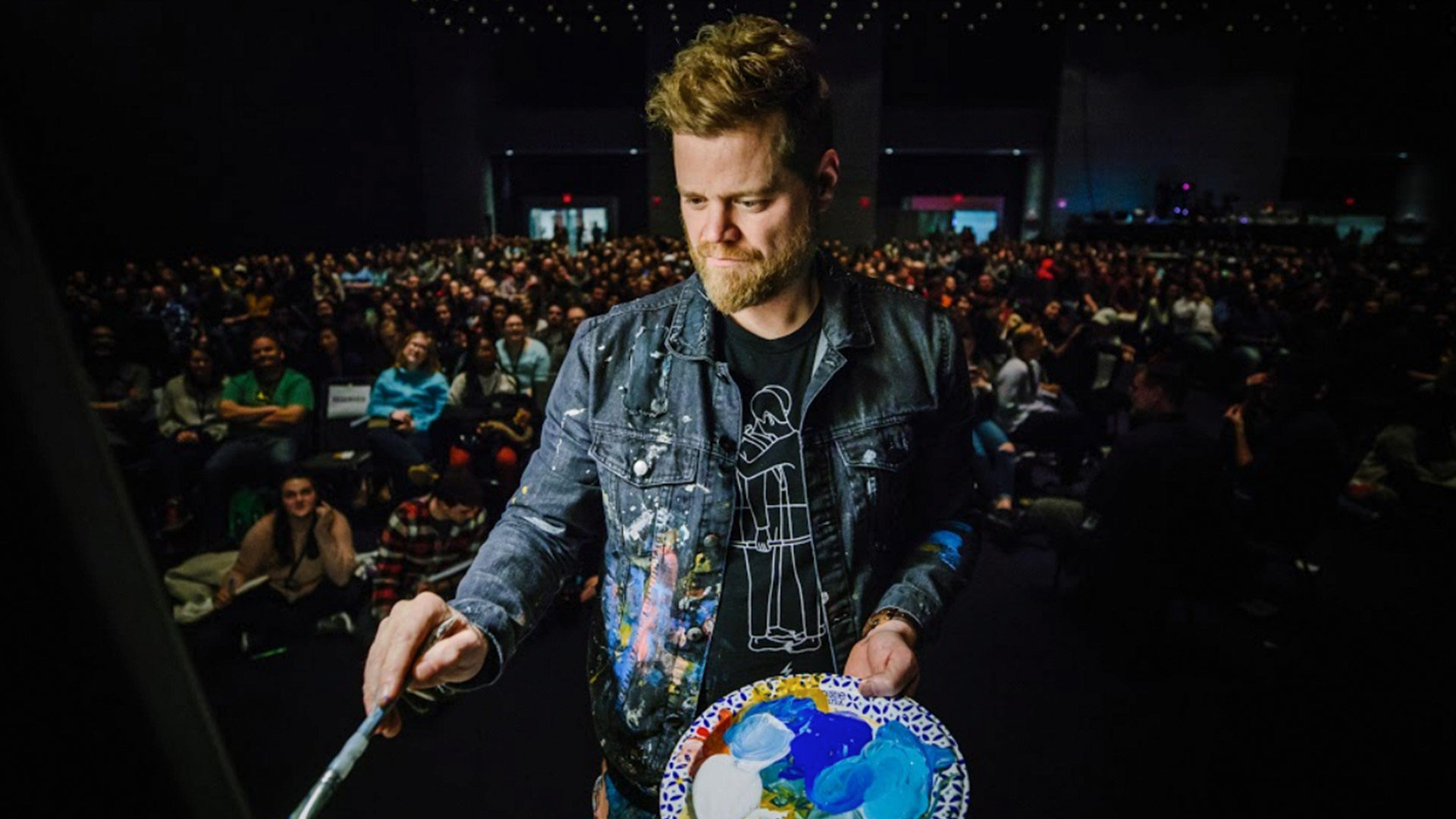Scott Erickson is a multi-hyphenate artist: a touring painter, co-author of two books, and a performer of autobiographical, multimedia, interactive plays. As Andrea Sielaff, researcher for Resilient Leaders Project at The Seattle School, conducted qualitative interviews about what contributes to resilience in ministry, Scott was identified as an exemplar of resilience by one of his peers. Andrea says, “ I was excited to interview him, to learn more about his resilience journey, in part because I met him in high school on a ministry trip to Scotland. His goofy humor impressed me then. His vulnerable resilience and soulful creativity inspire me now.” You can find more about Scott’s work and his upcoming tour at scottericksonart.com.
AS: What is your reaction to being identified as an exemplar of resilience?
SE: Laughter is my first response. I think it was surprising and humbling. What is weird about getting older and going through life is that things don’t get easier; they get more complicated. There have been elements of my faith that one time made a lot of sense but need to keep expanding alongside my lived experience.
I think what people see in me, in terms of resilience, is a willingness to see questions that arise about faith not as dead ends, but as doorways that open up possibility. If you are thinking, “I don’t know what to believe in that anymore,” you can see that as an ending or as a doorway to a deeper conversation. I’ve been curious in those places, like “Well where does this doorway go to?”
AS: What has helped you develop resilience in the midst of the unknown?
SE: As I’ve continued in my faith, I have had enough experience with God that I see him interacting and providentially leading in my life so that when I come across the new, the mysterious, the unknown, I can infer that that same providence is acting in this unknownness. It’s a deep sense of trust, and it gets deeper as every situation requires more trust. Even if I am angry or don’t like this place in my life, there is a sense that God loves me, that these circumstances are where I am invited into conversation with God. So I ask, “What is the conversation that I can have only from here? How can I learn here? Who is my teacher, and what am I discovering about myself and the world?”
An early contributor to my resilience was seeing models of dynamic faith through the lives of adults who were involved in an organization I was a part of when I was younger, Alongside Ministries. What is consistent in my faith now is practicing prayerful silence and solitude, taking times of moments of quiet and to allow myself to process the life I am in, to have a hidden practice of prayer and listening. I also meet with a spiritual director.
AS: The three pillars of resilience we talk about in the Resilient Leaders Project are People, Practices, and Purpose. There are two books you have co-created, with Justin McRoberts, that I think invite people into resilient practices and help them clarify purpose: Prayer: Forty Days of Practice and May It Be So: Forty Days in the Lord’s Prayer. The books use art and text to make space for those curious conversations with God that you’ve been talking about. What is it about art that facilitates conversation with God and self?
SE: A great question to ask about art is “what does it mean?” Another great question to ask is “what is it pulling out of you?”… because one of the wonderful functions that art has is that it becomes an excavation tool. It helps us get in touch with the deepest conversations that we are having. Have you ever been in the car, turned on the radio, and a particular song was playing that you turned up the volume loudly and exclaimed “this is my song!” What are you saying in the moment? Somehow the artist lyrically and sonically perfectly described what it’s like to be in your own skin. They helped you get in touch with the honest truth about you… and honesty is the doorway to a conversation with God.
AS: Many people develop resilience through an experience of burnout, a leadership crucible, or a personal crisis. You have explored your own ministry burnout experience in your one-man play, We Are Not Troubled Guests. Having seen the show, what was really powerful to me was your willingness to dive deep into your pain, to explore those places of hurt and harm instead of numbing them. In the play, you (literally) painted a picture of how resilient purpose can develop as the willingness to take apart all that had been so carefully constructed resulted in a new, more organic sense of calling. Do you think everyone needs to have an experience like this to truly develop resilience, or do you think skills can be taught and implemented ahead of those experiences?
SE: It feels like a catch-22 in a way. The best way to learn health can be from your unhealth, and failure can be the greatest teacher. But if you see someone on a really negative path, you don’t tell them to keep moving toward burnout. But, in some ways, I kind of think you might have to have this type of experience; what that looks like is different for each person. In part that is because there will always be part of your false self that will drive you to a place that is a dead-end, whether that is a need for accomplishment or serving in a way that is more about you than about others. There has to be the breaking of that ideal of your false self. The breaking of it can reveal a truer thing.
AS: Your latest performance piece, Say Yes: A Liturgy of Not Giving Up on Yourself, addresses this idea of letting going of that false self to embrace a wider sense of purpose. Can you tell us a little more about it?
SE: It’s a conversation—using story-teaching, participation, humor, and image curation—about who we are, why we are here, and what is the possible future that lies before us. It’s about the death of a dream and the overwhelming voice of Giving Up—and it’s about redeeming those things unto deeper hopes and vocation.
Liturgy simply means “the work of the people.” So when we gather together, I will be the story sherpa, I will do the heavy lifting, but it’s really a space to open up a conversation with your own life. We do together because it is through the forms of story, art, imagery, singing, comedy, and participation that we begin to slowly untie the narratives that we tell ourselves. And the magic that happens at the end is that we are able to see new possibilities for the future.
I wanted to make a church service about suicide… because I’ve never been to one. I think one of the hardest things about the miracle of life is that sometimes you come to a place where you don’t want the miracle anymore. Why is that? And how do you talk to the Giver of that miracle about it? Say Yes in my attempt to enter into that conversation with an audience.
You can restore your inner resilience and learn how to live into your purpose through the Certificate in Resilient Service. Learn more and apply today.


